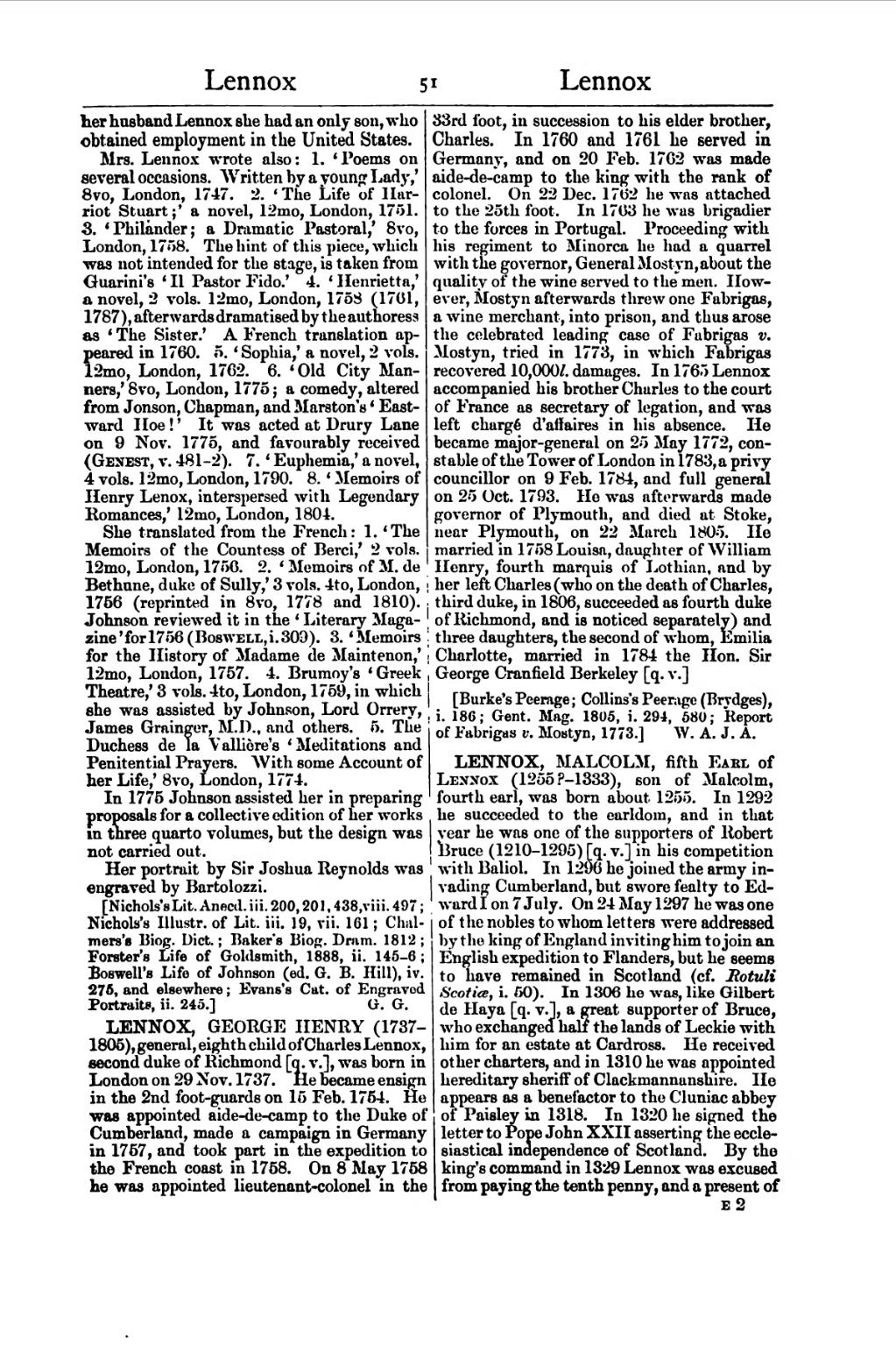her husband Lennox she had an only son, who obtained employment in the United States.
Mrs. Lennox wrote also: 1. ‘Poems on several occasions. Written by a young Lady,’ 8vo, London, 1747. 2. ‘The Life of Harriot Stuart;’ a novel, 12mo, London, 1751. 3. ‘Philander; a Dramatic Pastoral,’ 8vo, London, 1758. The hint of this piece, which was not intended for the stage, is taken from Guarini's ‘Il Pastor Fido.’ 4. ‘Henrietta,’ a novel, 2 vols. 12mo, London, 1758 (1761, 1787), afterwards dramatised by the authoress as ‘The Sister.’ A French translation appeared in 1760. 5. ‘Sophia,’ a novel, 2 vols. 12mo, London, 1762. 6. ‘Old City Manners,’ 8vo, London, 1775; a comedy, altered from Jonson, Chapman, and Marston's ‘Eastward Hoe!’ It was acted at Drury Lane on 9 Nov. 1775, and favourably received (Genest, v. 481–2). 7. ‘Euphemia,’ a novel, 4 vols. 12mo, London, 1790. 8. ‘Memoirs of Henry Lenox, interspersed with Legendary Romances,’ 12mo, London, 1804.
She translated from the French: 1. ‘The Memoirs of the Countess of Berci,’ 2 vols. 12mo, London, 1756. 2. ‘Memoirs of M. de Bethune, duke of Sully,’ 3 vols. 4to, London, 1756 (reprinted in 8vo, 1778 and 1810). Johnson reviewed it in the ‘Literary Magazine’ for 1756 (BOSWELL, i. 309). 3. ‘Memoirs for the History of Madame de Maintenon,’ 12mo, London, 1757. 4. Brumoy's ‘Greek Theatre,’ 3 vols. 4to, London, 1759, in which she was assisted by Johnson, Lord Orrery, James Grainger, M.D., and others. 5. The Duchess de la Vallière's ‘Meditations and Penitential Prayers. With some Account of her Life,’ 8vo, London, 1774.
In 1775 Johnson assisted her in preparing proposals for a collective edition of her works in three quarto volumes, but the design was not carried out.
Her portrait by Sir Joshua Reynolds was engraved by Bartolozzi.
[Nichols's Lit. Anecd. iii. 200, 201, 438, viii. 497; Nichols's Illustr. of Lit. iii. 19, vii. 161; Chalmers's Biog. Dict.; Baker's Biog. Dram. 1812; Forster's Life of Goldsmith, 1888, ii. 145–6; Boswell's Life of Johnson (ed. G. B. Hill), iv. 275, and elsewhere; Evans's Cat. of Engraved Portraits, ii. 245.]
LENNOX, GEORGE HENRY (1737–1805), general, eighth child of Charles Lennox, second duke of Richmond [q. v.], was born in London on 29 Nov. 1737. He became ensign in the 2nd foot-guards on 15 Feb. 1754. He was appointed aide-de-camp to the Duke of Cumberland, made a campaign in Germany in 1757, and took part in the expedition to the French coast in 1758. On 8 May 1758 he was appointed lieutenant-colonel in the 33rd foot, in succession to his elder brother, Charles. In 1760 and 1761 he served in Germany, and on 20 Feb. 1762 was made aide-de-camp to the king with the rank of colonel. On 22 Dec. 1762 he was attached to the 25th foot. In 1763 he was brigadier to the forces in Portugal. Proceeding with his regiment to Minorca he had a quarrel with the governor, General Mostyn, about the quality of the wine served to the men. However, Mostyn afterwards threw one Fabrigas, a wine merchant, into prison, and thus arose the celebrated leading case of Fabrigas v. Mostyn, tried in 1773, in which Fabrigas recovered 10,000l. damages. In 1765 Lennox accompanied his brother Charles to the court of France as secretary of legation, and was left chargé d'affaires in his absence. He became major-general on 25 May 1772, constable of the Tower of London in 1783, a privy councillor on 9 Feb. 1784, and full general on 25 Oct. 1793. He was afterwards made governor of Plymouth, and died at Stoke, near Plymouth, on 22 March 1805. He married in 1758 Louisa, daughter of William Henry, fourth marquis of Lothian, and by her left Charles [q. v.] (who on the death of Charles, third duke, in 1806, succeeded as fourth duke of Richmond, and is noticed separately) and three daughters, the second of whom, Emilia Charlotte, married in 1784 the Hon. Sir George Cranfield Berkeley [q. v.]
[Burke's Peerage; Collins's Peerage (Brydges), i. 186; Gent. Mag. 1805, i. 294, 580; Report of Fabrigas v. Mostyn, 1773.]
LENNOX, MALCOLM, fifth Earl of Lennox (1255?–1333), son of Malcolm, fourth earl, was born about 1255. In 1292 he succeeded to the earldom, and in that year he was one of the supporters of Robert Bruce (1210–1295) [q. v.] in his competition with Baliol. In 1296 he joined the army invading Cumberland, but swore fealty to Edward I on 7 July. On 24 May 1297 he was one of the nobles to whom letters were addressed by the king of England inviting him to join an English expedition to Flanders, but he seems to have remained in Scotland (cf. Rotuli Scotiæ, i. 50). In 1306 he was, like Gilbert de Haya [q. v.], a great supporter of Bruce, who exchanged half the lands of Leckie with him for an estate at Cardross. He received other charters, and in 1310 he was appointed hereditary sheriff of Clackmannanshire. He appears as a benefactor to the Cluniac abbey of Paisley in 1318. In 1320 he signed the letter to Pope John XXII asserting the ecclesiastical independence of Scotland. By the king's command in 1329 Lennox was excused from paying the tenth penny, and a present of
